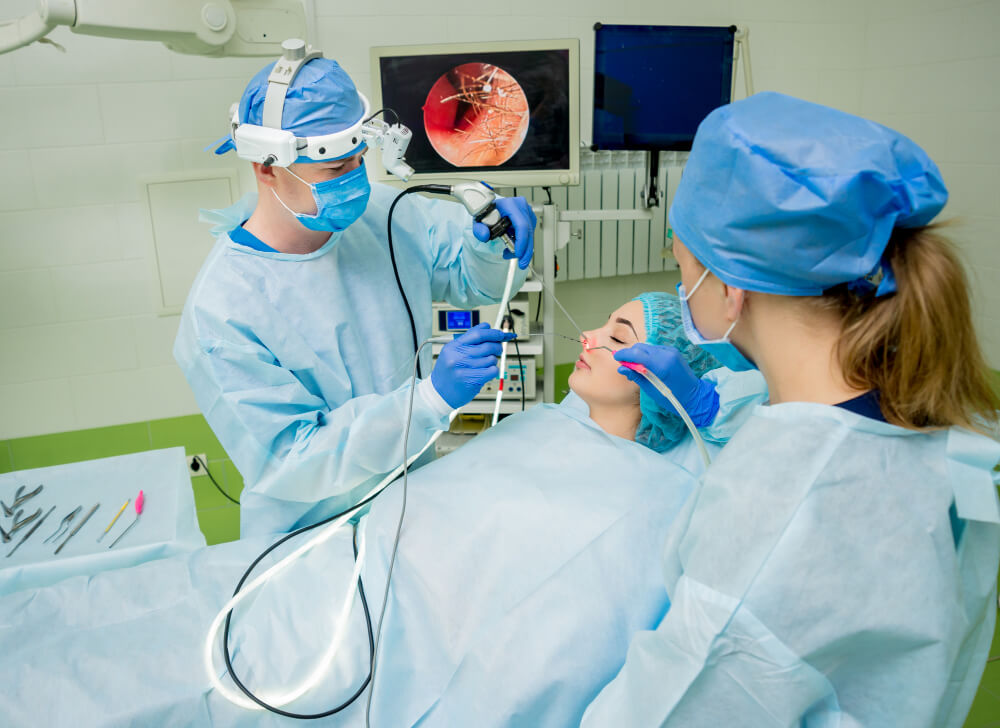Image Guidance Sinus Surgery Seattle
Over the years, sinus surgery has become less and less invasive. One of the latest advancements in sinus surgery comes in the form of image guidance sinus surgery. Image guidance sinus surgery uses imaging technology to identify blockages and structural problems in the sinuses. While the technology has been available since the 1980s, it took time to develop the intricate technique. Dr. David Santos of Sinusitis In Seattle is among one the first to adopt new, more effective procedures. Sinusitis In Seattle offers the best image guidance sinus surgery Seattle provides.
SINUS PROBLEMS
Sinusitis and sinus problems afflict millions of people every year. For most, their symptoms are temporary and will pass with little to no treatment in a couple of weeks. However, chronic sinus issues decrease the quality of life and interrupt daily activities for a few million sinus condition sufferers.
The most common sinus problems are the three forms of sinusitis: acute, subacute, and chronic. Acute sinusitis is likely the most frequently seen sinus condition. Acute sinusitis clears within four weeks, with most sinus infections ceasing within two weeks. This type of sinusitis rarely ever needs surgery. The main exception is for people who suffer from recurrent acute sinusitis.
Subacute and chronic sinus conditions have many of the same symptoms. However, chronic symptoms last longer and cause more issues within daily life. Subacute sinusitis usually clears within several weeks. Some forms may require surgery, but rarely. Chronic sinusitis, however, lasts at least three months and often longer.
Other sinus conditions can cause sinusitis or require surgical treatment. These conditions can include:
- Sinus headaches
- Nasal polyps
- Nasal obstruction
- Rhinosinusitis
- Deviated septum
If your symptoms persist and do not get better with non-surgical treatments, you may be a candidate for sinus surgery. Dr. Santos can evaluate your candidacy during a consultation.

OVERVIEW: WHAT IS IMAGE GUIDANCE SINUS SURGERY?
Image guidance sinus surgery–as discussed–uses imaging technology to take a high quality image. Normally, this involves a CT scan. During surgery, Dr. Santos will use the scan along with an image guidance system. This allows him to see the exact location of the surgical instruments. He will then guide them to the blockage.
This technology allows Dr. Santos to be precise and clear blockages using less invasive methods than traditional sinus surgery. Usually, the best candidates for image guidance sinus surgery are those that only need the sinuses widened or those with minor blockages. In more severe cases, Dr. Santos may recommend endoscopic sinus surgery.
How It Works
The CT scan that Dr. Santos will use to guide him during surgery is usually taken before surgery day. In the in-between time, he will map out the surgery. During surgery, Dr. Santos will insert the surgical tools through the nostrils, similar to balloon sinuplasty. He will then follow the image and guide shown on the screen.
Dr. Santos will be able to see the exact position of the surgical instruments. Once he reaches the problem areas, he will carefully remove the blockages and possibly widen the sinuses. If there are more areas to address, Dr. Santos will then maneuver to them using the CT scan as a guide.
Generally, image guidance sinus surgery takes less than an hour. Unlike other sinus surgery techniques, image guidance sinus surgery does not use an endoscope. This limits the number of instruments going into the nostrils. It is usually more comfortable for patients during and after surgery.
Dr. Santos may use local or general anesthesia for the procedure. If local anesthesia is used, Dr. Santos will likely prescribe or recommend an oral or IV sedative. Local anesthesia can decrease the risk of surgery and lessen recovery time. Dr. Santos can discuss which anesthesia choice is right for you during a consultation.
Benefits
There are many benefits and advantages to choosing image guidance sinus surgery if you are a good candidate. Among some of the benefits of the procedure include:
- Cessation or reduction in sinus symptoms including sinus headaches, congestion, postnasal drip, etc.
- More comfortable procedure
- Less painful
- Easier recovery
- Little or no need for prescription pain relievers after surgery
- Less risk than traditional surgery
- Imaging technology allows for precise surgery
- Creates less trauma than traditional surgery because the imaging allows Dr. Santos to maneuver easier through the nasal and sinus cavities

IMAGE GUIDANCE SINUS SURGERY vs. ENDOSCOPIC SINUS SURGERY
Image guidance sinus surgery and endoscopic sinus surgery both can treat and alleviate painful sinusitis symptoms. While the procedures are notably different, they do share some similarities. Examples of these similarities include that they are both performed solely through the nostrils and do not include external incisions. The table below details some of the major differences between the two procedures.
| Image Guidance Sinus Surgery | Endoscopic Sinus Surgery |
|
|
PREPARING FOR SURGERY
If traditional and non-surgical therapies have failed in reducing or treating your sinusitis symptoms, Dr. Santos may recommend sinus surgery. At a consultation, he will evaluate you to determine which type of sinus surgery will benefit you best. If Dr. Santos determines you are a good candidate for image guidance sinus surgery, he will describe the procedure in detail. He will also explain the ways you need to prepare for surgery.
Dr. Santos will look over your current medications and may ask you to cease the use of certain ones before surgery, if possible. He will also give instructions based on your anesthesia choice. You will also need to arrange for a caregiver after surgery and any necessary work and childcare arrangements.
RECOVERY AFTER IMAGE GUIDANCE SINUS SURGERY
Following surgery, you will wake up or come to after surgery. Usually, patients remain at Sinusitis In Seattle for an hour or two for monitoring before going home with their caregiver. You will likely feel groggy and tired. Also, it is common for patients to be congested for around a week.
You should not blow your nose at all for at least 24 hours and avoid strenuous exercise for about a week. Most patients feel well enough to return to most of their daily activities within a few days. However, patients should not return to work until obtaining clearance from Dr. Santos.
FREQUENTLY ASKED QUESTIONS
What Is The Success Rate Of Sinus Surgery?
All sinus surgeries are considered an effective way to address chronic sinusitis and symptoms. Generally, sinus surgery is 80-90% effective. For people who suffer from daily sinus problems, this is well worth it.
While sinus surgery may not totally alleviate all sinus symptoms, it usually makes them easier to manage and live with. Most of the time, patients expect complete or nearly complete cessation of symptoms. Some patients do undergo additional sinus surgeries in the future. Though, this is relatively rare and more common in people with conditions like nasal polyps that are more likely to recur.
Can You Get A Black Eye From Sinus Surgery?
Yes, like any surgery, bruising is possible. Since the sinuses are located near the eye, this can result in bruising around the eye. If bruising occurs, it will appear over the next few days after surgery. Typically, this will resolve within a week or so, and easy to hide after the first couple of days.
When Will I Get My Results?
Over the first week, you will likely experience congestion and bloody discharge from the nose. This is normal during the healing process and Dr. Santos will prescribe sinus irrigation supplies to decrease discomfort. Usually, results from sinus surgery take one to two months to settle. Therefore, you will continue seeing Dr. Santos for a few months to monitor progress. Dr. Santos will also determine if long term management such as allergy medications or other similar treatments may still be necessary.
Can It Help With Headaches?
Yes, stealth sinus surgery can alleviate or reduce sinus headache pain. Depending on the cause of your sinusitis and headaches, stealth sinus surgery may correct the issues. Headaches are normal for a short time after surgery due to congestion and inflammation. These should subside throughout recovery.
When Is Image Guidance Sinus Surgery Preferred?
ENT surgeons tend to prefer stealth sinus surgery when a patient’s sinus anatomy is particularly unusual, narrow, or difficult. It is also frequently used during revision surgeries because of scar tissue that may present in the sinuses. The CT scan and imaging technology allows Dr. Santos to better maneuver through these areas. This often results in a more effective and less traumatic surgery.
Other patients may also find benefit from stealth sinus surgery. Dr. Santos can discuss the various options and which may work for you at a consultation at Sinusitis In Seattle.
THE GOLD STANDARD OF SINUS SURGERY AT SINUSITIS IN SEATTLE
Dr. David Santos is an accomplished Ear, Nose, and Throat specialist with board certifications in otolaryngology and facial plastic surgery. This makes him uniquely qualified to perform non-invasive sinus surgery. Dr. Santos has three decades of experience treating sinusitis of all types and performing sinus surgery.
Offering premier surgical and non-surgical treatment of sinus problems, Sinusitis In Seattle is the top destination for the best ENT Seattle offers. To learn more about acute sinusitis and to schedule a consultation, call us at (206) 242-3696 or contact us online.
Contact Us
